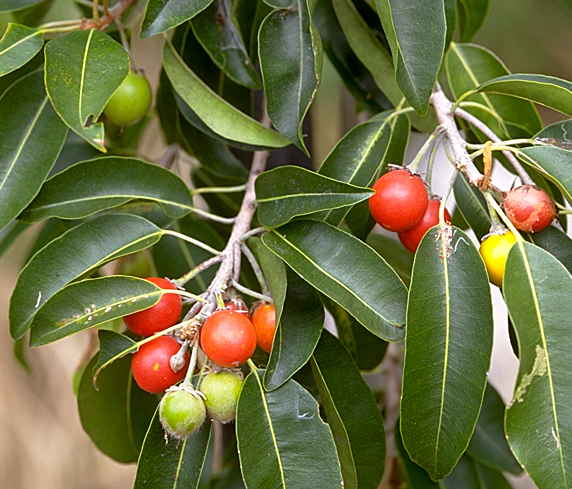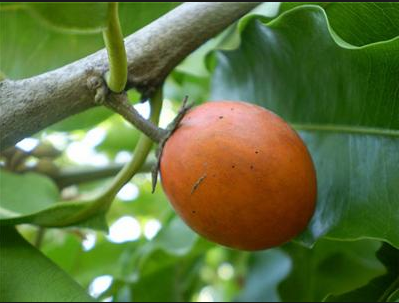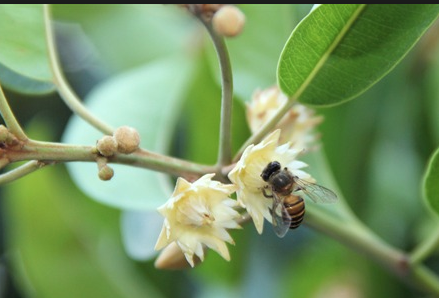
Spanish Cherry fruit is edible and is related to Monkey’s Apple
Foraging is treasure hunting for adults. Not only is finding food fun but finding new food you didn’t know about is a joy as well. That happens reasonably often during my foraging classes in sub-tropical south Florida.

The ripe fruit ranges from yellow to orange to red.
As far as I know there is no complete accounting of all the plants in Dreher Park, West Palm Beach. And it suffered significant storm damage particularly hurricanes a decade ago but also Hurricane Irma last year. I had been teaching in the park for several years and had walked past this particular tree many times, at the end of a street near a foot entrance (that might be a clue to finding other “treasures.”) This time, however, the ground was covered with orange orbs. Hundreds of inch-long “bullet”-shaped fruit that resemble a small persimmon except longer (and the calyx was different and a key identifier.) As you can imagine doing a Goggle search for “Florida fruit orange” was not helpful. I eventually identified it as the south Asia native Mimusops elengi, Spanish Cherry, Bullet Wood, and Malabar Plum. Oddly it is not listed in the good book “Tropical Trees of Florida and the Virgin Islands.” Its central native range is India and surrounding areas where it is called Bakul along with over one hundred local names (yes, I counted them.) Interestingly it has a relative that is also cultivated in south Florida and like warm areas, Monkey Apples, or M. coriacea. They are both in the greater Soursop group.
As for the botanical name, Mimusops (MIM-you-sops) comes from the Greek words, mimo meaning ape, and ops meaning resembling. In English we would say “looks like a monkey.” “Elangi” — ee-LAN-gee — is from the common Malabari name for this tree and flower though it is also called the Tanjong Tree.

The evergreen tree is quite valuable commercially and otherwise. The wood is hard — is that why it is called Bullet Wood or possibly because of the shape of the fruit — and is deep red. The fruit is orange to red and edible. Various parts of the tree have also been used in Ayurvedic medicine (see Herb Blurb below.) It’s considered a prize addition to gardens for its fruit and fragrant flowers. The tree won’t grow in temperate climates but can survive subtropical areas and is tolerant of light frosts but not salty areas. The fruit reminds one of small persimmons in color and mild taste when ripe but a different texture, mealy. The tree’s bark resembles an oak but the leaves favor a Magnolia look and at one time the tree was named in that genus. Definitely a tree to look out for (I even brought home a seed for pot planting.) I think Mr. Dreher, Superintendent of Parks, would be proud.

Dreher Park was the main project of Paul Dreher, a German immigrant, who came to the United States in the 1920s from Wurttenberg. (He had an aunt who was among the pioneer settlers of Delray Beach in 1895.) Thus a foraging fellow from a cold climate got a chance to create a park in a warm place before the advent of lawyers and rabid municipal liability. The “Johnny Appleseed” of West Palm Beach, Dreher had a degree in horticulture from the University of Hohen-Heim in Stuttgart. He was hired for 25 cent an hour then later $5 a day. His projects included picking thousands of trees for the city’s streets, Flager Park, Currie Park, Phillips Park, and Bacon Park. In 1951 Dreher convinced the city to buy 108 acres for a park. The city came up with $100 to buy the land but would not fund its development. Dreher scrounged plants for ten years, rummaging around landscapers’ dumps and taking donations. That became the basis for what is now Dreher Park. (The loud interstate to the west, I-95, was not built until the 1964.) Six farm animals Dreher had on the property — a goat, two chickens, two ducks and a goose, valued at $18 total — became the beginning of the Palm Beach Zoo. Dreher, whose hobby was collecting rocks in rockless Florida, also was involved after his retirement in the landscaping of the city of Palm Beach Gardens, the PGA National Golf Course and Lion Country Safari. He died in 1993, at age 90. His wife of 63 years, Alice Irene Owen, died nine years later in 2002, age 92. Dreher’s philosophy was “Anything green that grows is good. You just have to control it.”
Green Deane’s Itemized Plant Profile
IDENTIFICATION: A large glabrous evergreen tree from 50 to 90 feet, with a relatively short trunk and a compact leafy crown, bark smooth, scaly, and gray, Leaves spirally arranged, four inches long, and inch wide, elliptic shortly acuminate, glabrous, base acute or rounded, flower star-shaped, white, fragrant, solitary buds, fruit about an inch long, similar to a small olive, ovoid, yellow to red when ripe, seed solitary, ovoid, compressed, brown, shiny. The wood is very hard.
TIME OF YEAR: Blossoms in Fall, fruit is the new year here in Florida, or, it can blossom in the spring and fruit in early summer.
ENVIRONMENT: Full sun, average water, dryer areas than wetter areas, it does not like its wet feet. Grows year round, evergreen. Does not like to be close to the sea shore. Inland a few miles is fine. Endures high winds well.
METHOD OF PREPARATION: Fruit edible raw, cooked, pickled, seed oil is used for cooking but also used for lamps. The fatty acid line up is oleic acid 64%, linoleic acid 14.5%, palmitic acid 11%, stearic acid 10% and behenic acid 0.5%. Bark oil is used in making perfume. Blossoms are used for potpourris.
HERB BLURB
The bark is acrid and sweet; cooling, cardiotonic, alexipharmic, stomachic, anthelmintic, astringent; cures biliousness and diseases of the gum and teeth[1],[2]. The flowers are sweet, acrid, oleagenous; cooling, astringent to the bowels; good for the teeth, causes flatulence. They are used as expectorant; cures biliousness, liver complaints, diseases of the nose, headache, and their smoke is good in asthma[3]. The seeds fix loose teeth; as an errhine cures nasal congestion and headache[4]. The root is sweet and sour; aphrodisiac, diuretic, astringent to the bowels; good for gonorrhoea; as a gargle, strengthens the gums[1]. The fruits are sweet and sour, aphrodisiac, diuretic, astringent to the bowels, good in gonorrhoea. The pulp of the ripe fruits is sweetish and astringent and has been successfully used in curing chronic dysentery[1],[5]. The leaves are well known for analgesic and antipyretic

